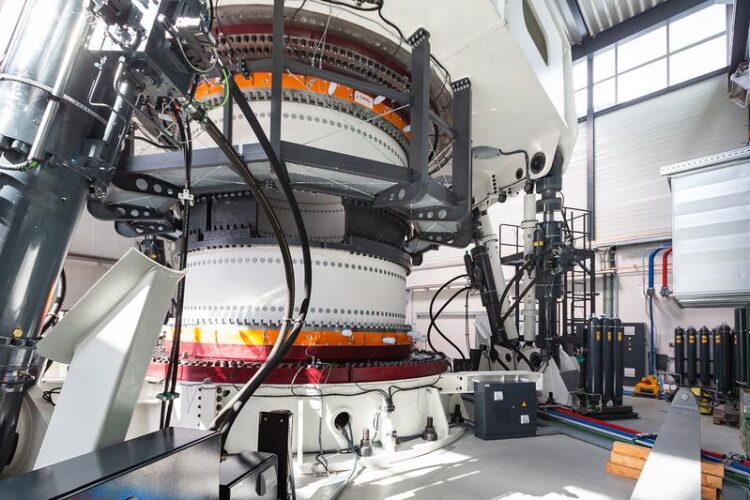Accelerated testing of rotor blade bearings

Rotor blade bearings measuring 3 to 6.5 m in diameter are tested for offshore wind turbines at the highly innovative BEAT6.1 large bearing test bench.
© Fraunhofer IWES/Ulrich Perrey
Test bench proves successful in regular operation
The Fraunhofer Institute for Wind Energy Systems IWES has completed a successful series of accelerated tests on rotor blade bearings at the bearing test bench in Hamburg. Within the scope of research and industry projects, bearings were subjected to dynamic endurance tests to increase their reliability and gain insights into the causes of wear. The first bearing tests were thoroughly successful with both the test method developed by Fraunhofer IWES and the test bench itself proving their worth. Accelerated test procedures allow the institute to acquire vital insights into damage mechanisms that can reduce future development costs and yield losses.
The accelerated testing of rotor blade bearings as part of research and industrial projects at Fraunhofer IWES has been a complete success. During testing, the load is applied to a bearing by means of six hydraulic cylinders on the BEAT6.1 (Bearing Endurance and Acceptance Test) test bench with up to 50 meganewton meters (MNm) of static load. The test bench also simulates the movements of a wind turbine during operation together with the associated load changes. This accelerated test can thus recreate loads equivalent to 20 years of operation in just four to six months. Since its commissioning in May 2019, the Fraunhofer IWES has tested a range of bearing types for a 7.5 MW wind turbine.
In the HAPT (Highly Accelerated Pitch Bearing Test) research project, the institute concentrated first and foremost on the use of IPC (individual pitch control) for rotor blade bearing endurance tests. IPC is a measure aimed at reducing wind turbine loads: It aligns the loads of the individual rotor blades against each other in order to reduce the loads acting on the wind turbine structure. The test results for the first bearings have shown that the wearing behavior can be recreated successfully on the test bench.
“During the tests, we demonstrated that the load application works with a dynamic accuracy of 0.1 percent. We were also able to test our continuous operation concept to great success. In addition, we gained valuable insights into the development of wear in blade bearings, which can subsequently prevent wear,” said Dr. Matthias Stammler, Senior Engineer at the Fraunhofer IWES.
Testing of the rotor blade bearings for the first industrial projects highlighted bearing-specific challenges which provide our customers with key insights into damage mechanisms. This, in turn, allows future development costs to be lowered and yield losses to be reduced.
The Fraunhofer IWES testing concept is continuously being optimized and expanded. For example, the institute is set to test a novel type of bearing in a next step: T-solid bearings.
“T-solid bearings boast a higher fatigue life compared with four-point bearings. We are now looking forward to putting this design through wear endurance testing in comparison with four-point bearings to check its operational suitability,” explained Hubertus Frank, Head of Technology, IMO Group.
Wissenschaftliche Ansprechpartner:
Dr.-Ing. Matthias Stammler, Senior Engineer, Department of Reliability and Validation
Fraunhofer Institute for Wind Energy Systems IWES
Large Bearing Laboratory, Am Schleusengraben 22, 21029 Hamburg, Germany
Tel. +49 (0)471 14290-522, matthias.stammler@iwes.fraunhofer.de
Media Contact
All latest news from the category: Machine Engineering
Machine engineering is one of Germany’s key industries. The importance of this segment has led to the creation of new university degree programs in fields such as production and logistics, process engineering, vehicle/automotive engineering, production engineering and aerospace engineering among others.
innovations-report offers informative reports and articles covering technologies such as automation, motion, power train, energy, conveyor, plastics, lightweight construction, logistics/warehousing, measurement systems, machine tools and control engineering.
Newest articles

First-of-its-kind study uses remote sensing to monitor plastic debris in rivers and lakes
Remote sensing creates a cost-effective solution to monitoring plastic pollution. A first-of-its-kind study from researchers at the University of Minnesota Twin Cities shows how remote sensing can help monitor and…

Laser-based artificial neuron mimics nerve cell functions at lightning speed
With a processing speed a billion times faster than nature, chip-based laser neuron could help advance AI tasks such as pattern recognition and sequence prediction. Researchers have developed a laser-based…

Optimising the processing of plastic waste
Just one look in the yellow bin reveals a colourful jumble of different types of plastic. However, the purer and more uniform plastic waste is, the easier it is to…



